5. Astro Blasters
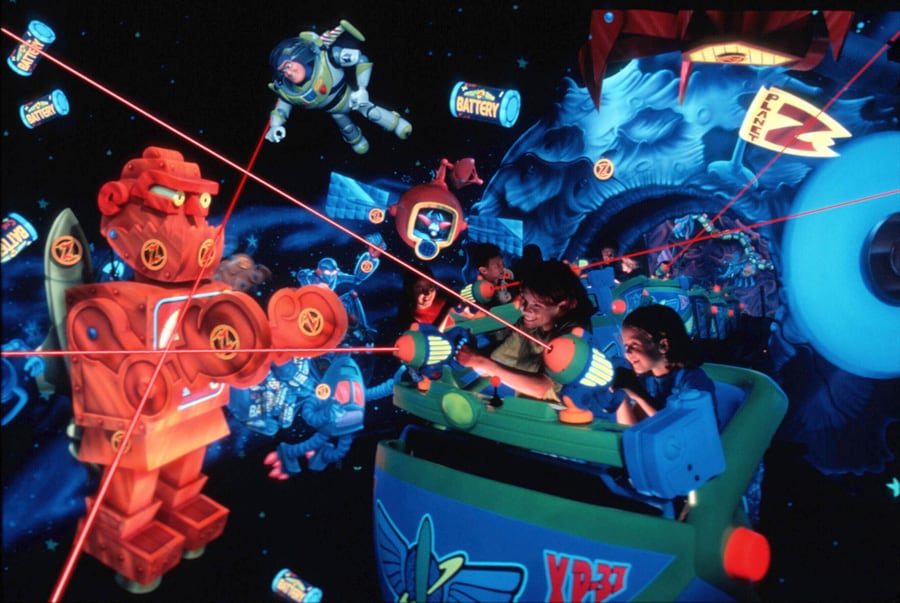
When Disney signed a three-picture distribution deal with Steve Jobs’ no-name animation studio called Pixar in 1991, it was a risk. Would anyone really want to sit through a full-length, computer-animated film? Suffice it to say that 1995’s Toy Story signaled that maybe – just maybe – computer animation could pay off. Thirty years later…. well…
We explored the proliferation of Pixar throughout Disney Parks in our Member-exclusive Disney·Pixarland Special Feature, but no ride represents the “Pixarification” of Disney Parks quite like Buzz Lightyear dark rides around the globe. Spoiler alert, but a Buzz Lightyear laser-blasting dark ride became one of the very, very few attractions to be at every Disneyland-style “Castle Park” on Earth… even if one park sent Buzz packing “to infinity and beyond” while another plans to close its copy. Think you know which ones?
A. Buzz Lightyear’s Space Ranger Spin (Magic Kingdom, 1998)
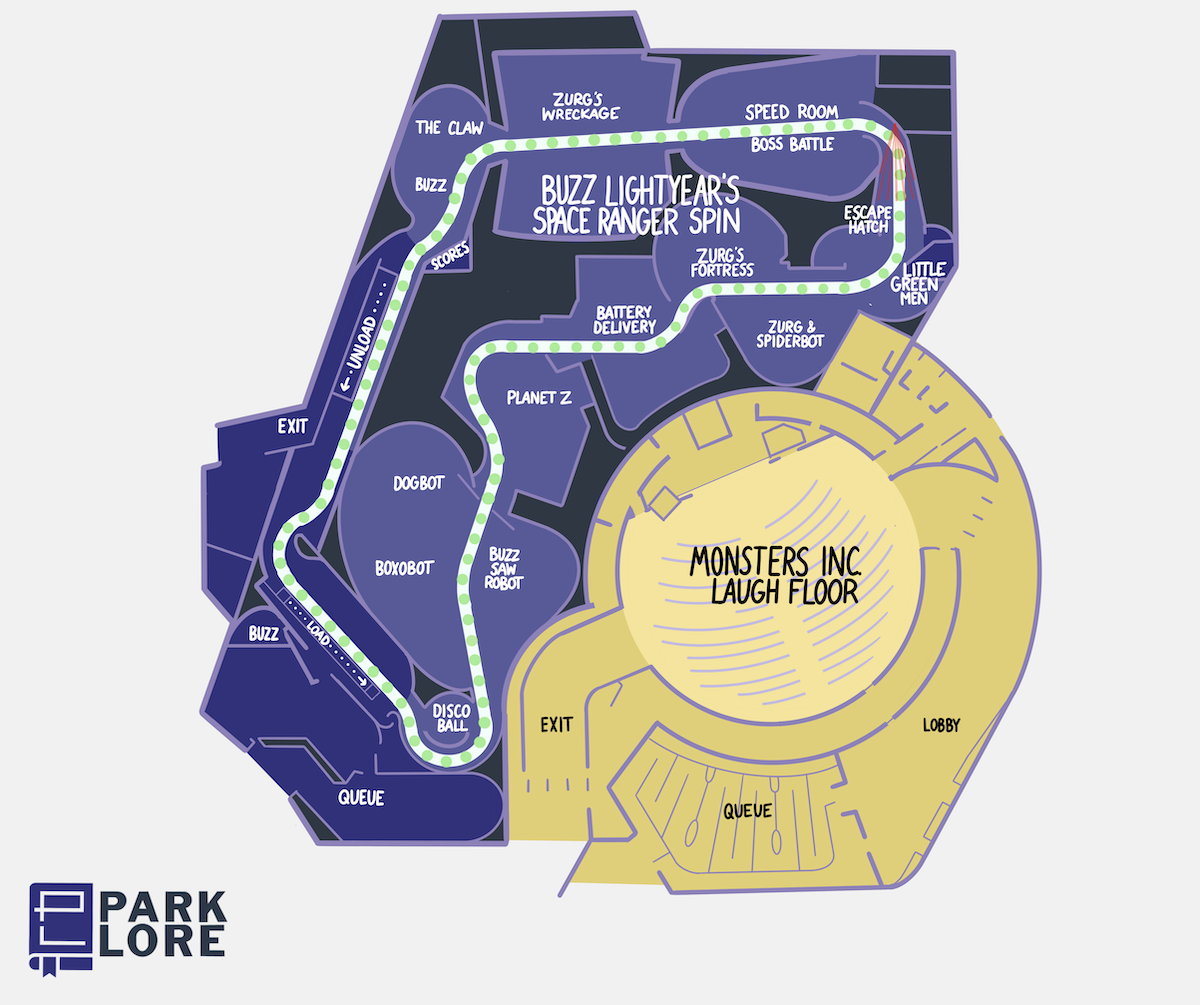
Opened in 1998, Buzz Lightyear’s Space Ranger Spin at Magic Kingdom brought an interactive, laser-blasting dark ride to Tomorrowland. It was not only the first Pixar addition to Magic Kingdom, but the beginning of the “cartoonification” of Tomorrowlands across the globe. (As evidence of just how quickly Tomorrowland shifted, Space Ranger Spin opened just three years after the sci-fi originals of Magic Kingdom’s then-New Tomorrowland: Alien Encounter and The Timekeeper).
Unlike the Buzz rides that followed, Disney World’s re-used an existing ride system, merely re-dressing the remains of the Lost Legend: If You Had Wings. (You can compare If You Had Wing and Space Ranger Spin in our Then & Now feature.)
There’s good and bad to having taken over an existing ride. For example, Magic Kingdom’s Buzz Lightyear ride benefits from the former occupants’ large scenes, its clever layout squeezed around the park’s CircleVision theater (today, Monsters Inc. Laugh Floor), and the projection-based “Speed Room” finale that makes Magic Kingdom’s version one-of-a-kind. But it’s also functioning on original 1972 mechanics that make the original version of the ride a little creaky after fifty years.
B. Buzz Lightyear Astro Blasters (Disneyland, 2005)
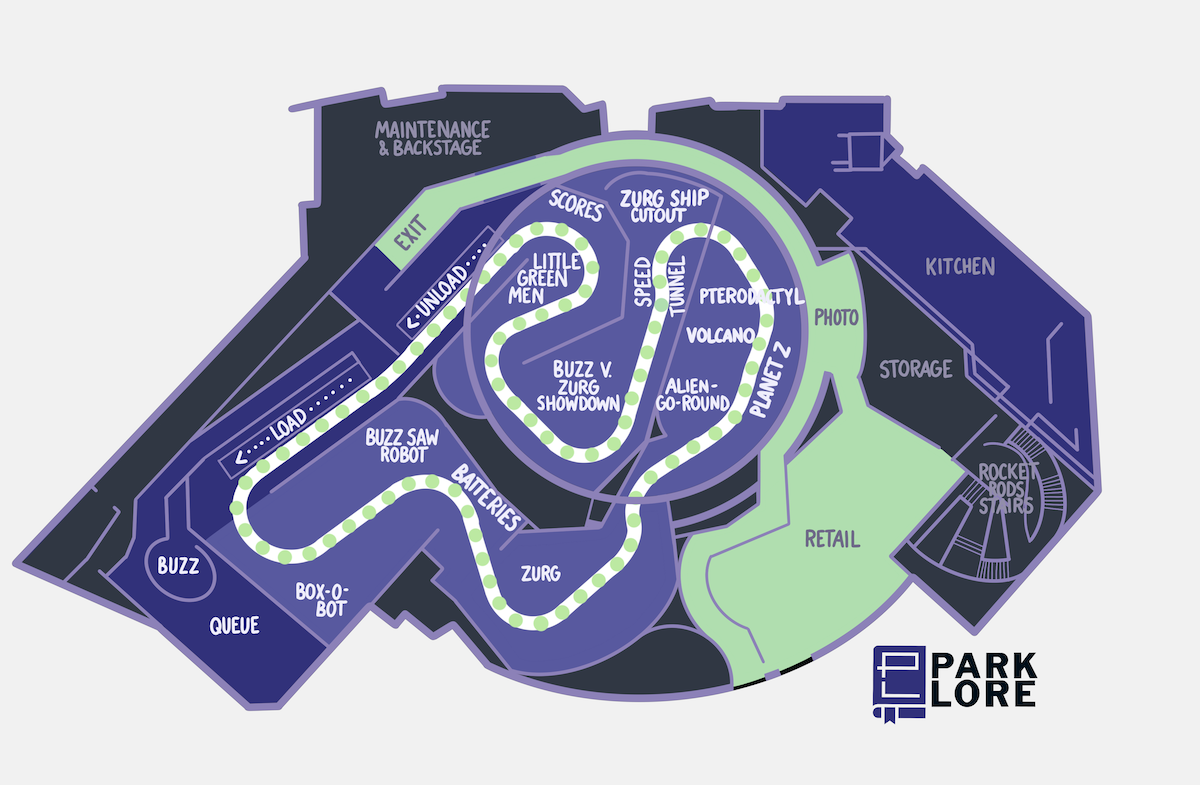
Once upon a time, Disneyland had an Omnimover dark ride along the entryway to its Tomorrowland, but it was replaced by STAR TOURS in 1987 – long before Toy Story. So to bring Buzz to California, a whole new, from-scratch Omnimover was constructed just a few steps away.
Technically, California’s Buzz Lightyear ride was built in the park’s CircleVision 360 theater (just as Tokyo Disneyland’s version of the ride had been the year prior). But when Buzz Lightyear moved in in 2005, that space hadn’t actually shown a CircleVision movie in nearly a decade. Instead, the nine-screen theater had been used as the queue for the infamously short-lived Declassified Disaster: The Rocket Rods. (Guests had queued in the theater, then descended a staircase that passed underground before climbing the central pedestal at the land’s center, boarding high speed hot rods where the placid Lost Legend: The PeopleMover had once loaded.)
All things considered, Imagineers should be proud of what they were able to squeeze into the circular theater space… but at the same time, there was – and probably still is – a better way to re-activate the north showbuilding along Tomorrowland’s entry than wedging in a dark ride like Buzz Lightyear Astro Blasters.
C. Buzz Lightyear Laser Blast (Disneyland Paris, 2006)
With the now go-to model of readapting CircleVision theaters into Buzz Lightyear rides, a third nine-screen theater – this time in Paris – was converted in 2006. The difference is that instead of being empty or underutilized, Paris’ nine-screen theater had been home to the iconic Lost Legend: Le Visionarium, representing a sad loss for the park. In a naked attempt to get you to follow @themeparklore on Twitter and engage with and share my posted thread of layouts there, you can exclusively see Disneyland Paris’ version of the ride here!
6. Pirates of the Caribbean
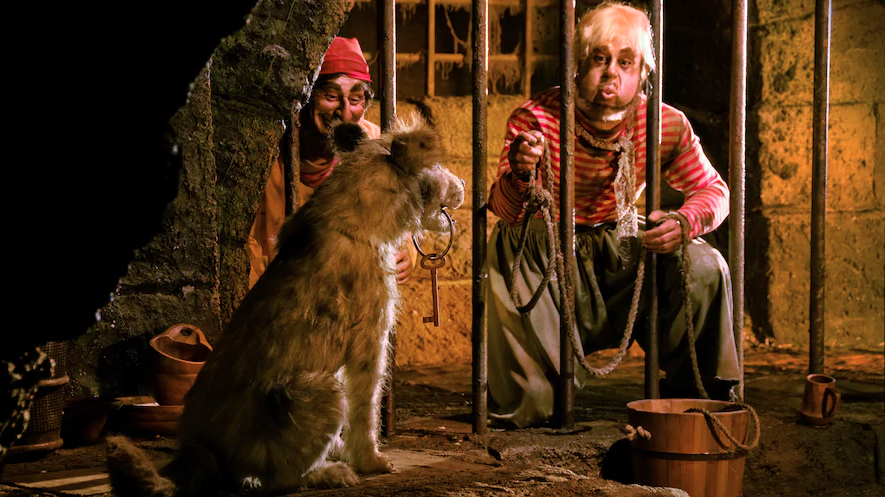
There are a few Disney Parks rides so iconic, they’re known even by those who’ve never been to the parks themselves. Arguably, Pirates of the Caribbean is as quintessentially “Disney” as you can get. But depending on the first place you rode it, you probably have different ideas about what scenes it includes and in what order…
A. Pirates of the Caribbean (Disneyland, 1967)
When Walt Disney and his team first envisioned a Pirates attraction for Disneyland’s New Orleans Square, it was expected to come in the form of a walkthrough wax museum. Once the basements that would’ve housed the attraction were dug, though, plans began to grow. Walt was instrumental in the ride’s design and construction. Even though he passed away four months before its opening, Pirates of the Caribbean is often considered his “magnum opus,” and easily among the greatest “classic” dark rides of all time.
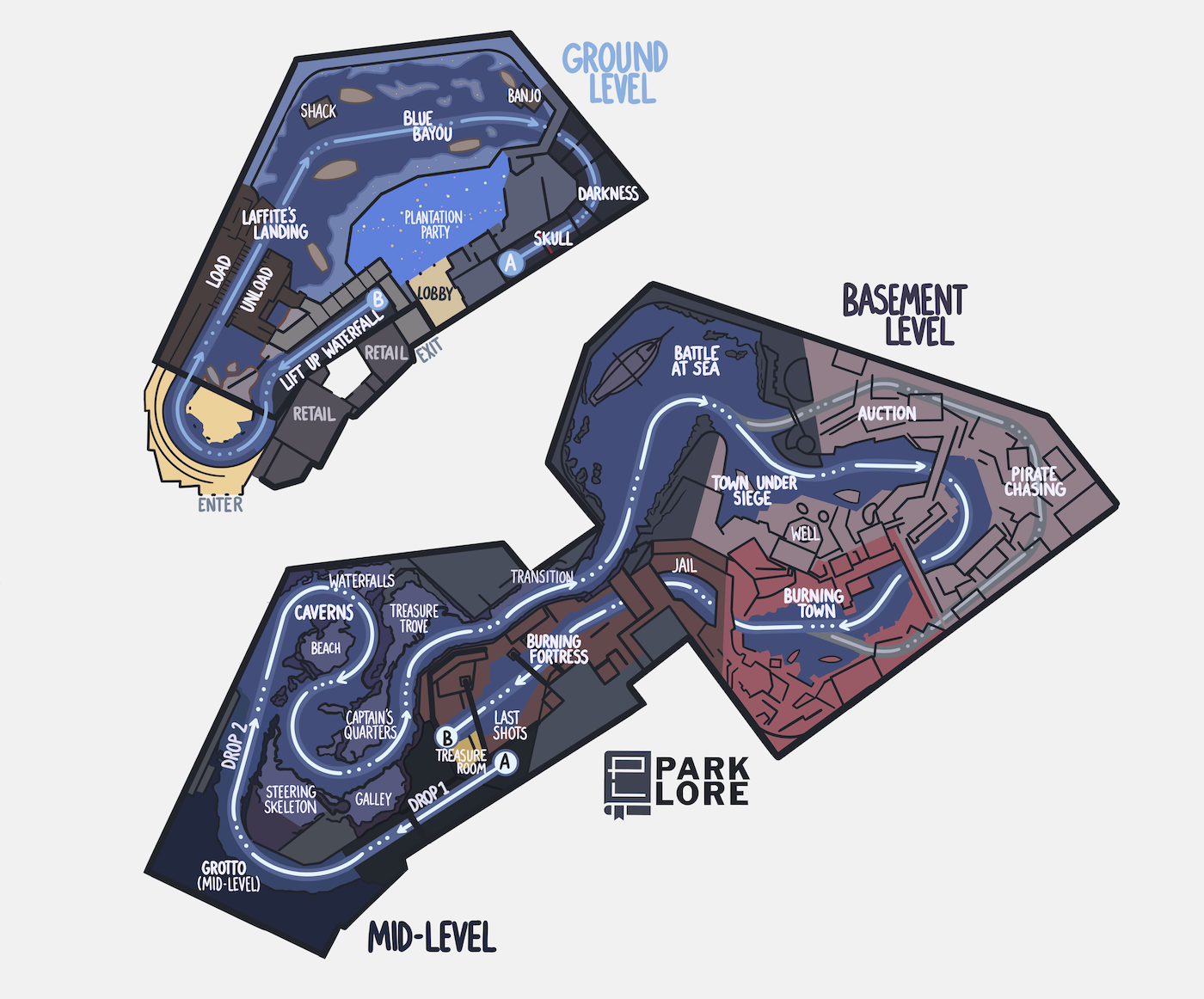
Arguably, in sixty years, only one ride (Star Wars: Rise of the Resistance) has come anywhere close to matching the original Pirates’ scale and scope. The sixteen minute attraction takes place across three levels, beginning in the iconic Blue Bayou. There, beneath perpetual night skies, guests drift through a Louisiana swamp of bobbing fishing boats, flickering fireflies, singing crickets, and a fancy, lantern-lit garden party populated not by animatronics, but by real diners (thanks to the in-ride Blue Bayou Restaurant).
Disneyland’s Pirates winds through ancient, water-carved caverns, misty grottos, and two different drops before arriving at the Battle at Sea, passing through the Town Under Siege, and then into a Burning Fortress. Riders then ascend back up a waterfall to ground level and return to Lafitte’s Landing. When it’s all said and done, the dark ride clocks in at an epic sixteen minutes, making it one of the most legendary “bucket list” attractions on Earth.
(Tokyo Disneyland’s Pirates looks almost exactly like Disneyland’s – including the Blue Bayou – but it skips the “Grotto” level and unloads riders in the Basement instead of riding back up to Ground Level, bringing the whole thing in at around ten minutes.)
B. Pirates of the Caribbean (Magic Kingdom, 1973)
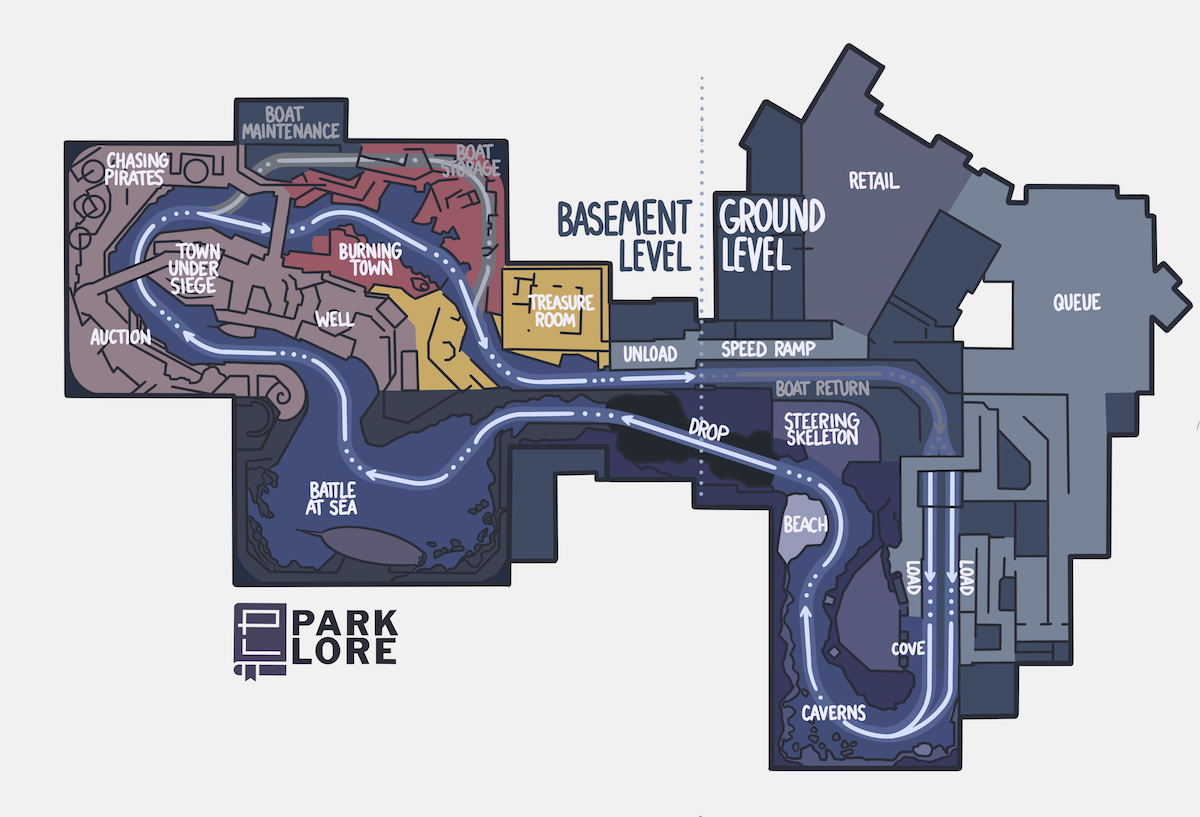
When Magic Kingdom opened in 1971, many of Disneyland’s most classic rides had been brought to Florida, even in modified form. But not Pirates. That’s because one of the Imagineers behind the Pirates ride – Marc Davis – had drawn up plans for a one-of-a-kind Frontierland-set counterpart custom made for Magic Kingdom: the Possibilityland: Western River Expedition. But as the story goes, guest demand was so high for “the Pirate ride” that plans for the Western River Expedition were scrapped and a version of Pirates was fast-tracked for Florida on a shortened timeline and budget.
It’s no secret that Magic Kingdom’s version of Pirates was a relative quick fix solution for the park. It omits Disneyland’s more contemplative, atmospheric scenes (like Lafitte’s Landing and the Blue Bayou) and drastically shortens others (like the Caverns and the Burning Fortress); it has just one drop, and then unloads guests at Basement Level rather than carrying them back up to Ground Level. Trace both Disneyland and Magic Kingdom’s layouts and you’ll be shocked how quickly Magic Kingdom’s cuts to the Battle at Sea!
Even so, the Florida version of the ride did its job. Magic Kingdom’s Pirates hits all the postcard-worthy highlights of the Disneyland original, but in about half the runtime. It’s still a good ride. It’s just not a “magnum opus” level attraction.
C. Pirates of the Caribbean (Disneyland Paris, 1992)

In general, both Magic Kingdom and Tokyo Disneyland were content with imitations of Disneyland’s original Pirates. But as with their unique Space Mountain, Disney’s first European park gave designers their first opportunity (and really, requirement) to rethink Disney Parks “classics” with a fresh perspective. It’s not surprising that most of Pirates’ standards stayed. What might be unexpected, though, is how they were rearranged.
Disneyland Paris’ ride begins by drifting through the Blue Lagoon (an Adventureland-appropriate, rainforest reimagining of the Blue Bayou) complete with diners at the waterfront Captain Jack’s Restaurant. Where American fans would expect to drop down a level, you instead rise two.
From there, the three classic “acts” are essentially reversed. The ride begins high up in the Burning Fortress (complete with views of the Battle at Sea below, and the iconic “Jail” scene that typically mark the ride’s end). The boats then plunge down a drop, splashing into the Battle at Sea, Town Under Siege, and Burning Town. Only then does a second drop bring riders down into the Caverns that serve as the ride’s opening act elsewhere. Even the talking skull that signals the ride’s start in the U.S. gives the unload spiel in Paris.
Since Paris’ Adventureland is set in the heyday of piracy, it makes good chronological sense that riders are already in the time and place where the story of Pirates of the Caribbean unfolds without the need for the “time travel” framing devices used elsewhere. At twelve minutes long, with three levels, and with several unique scenes, Paris’ Pirates is arguably the second best version of the ride, which is very high praise indeed.
D. Pirates of the Caribbean: Battle for Sunken Treasure (Shanghai Disneyland, 2016)
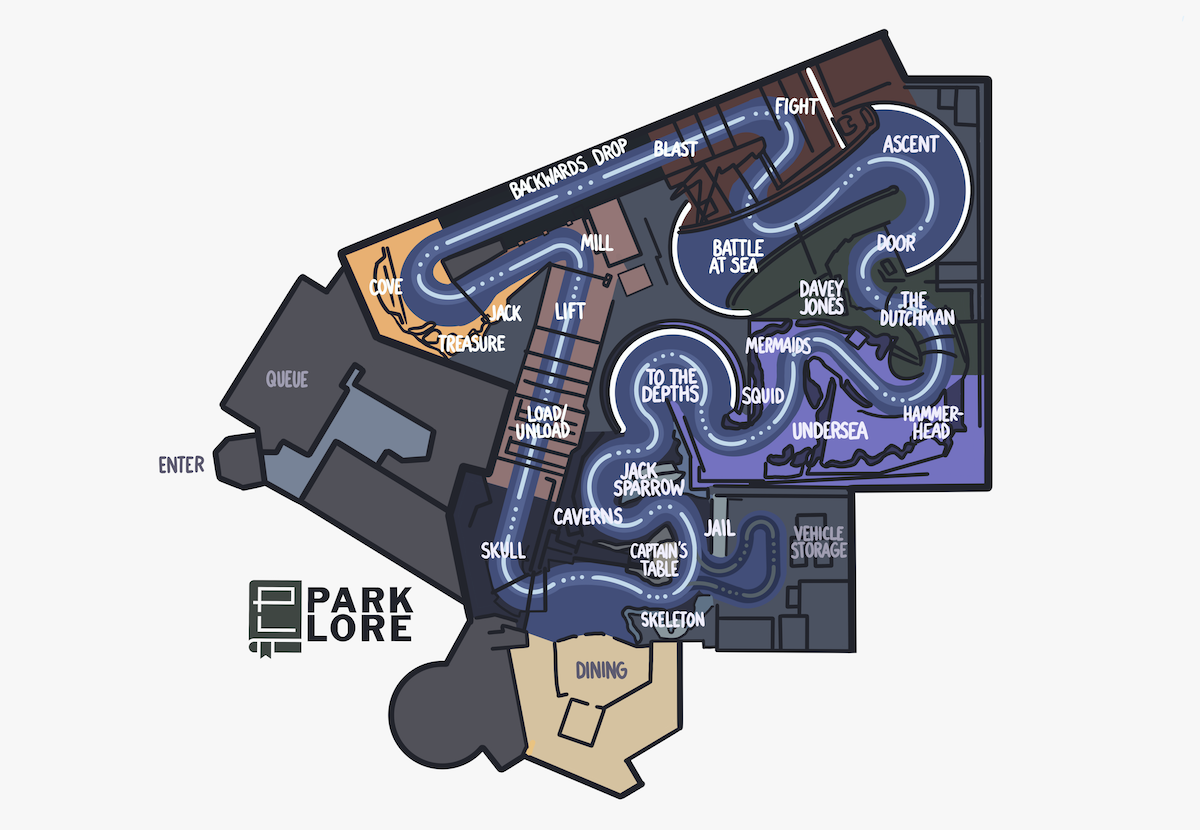
When Shanghai Disneyland opened in 2016, it introduced a whole new generation of Disney Parks E-Tickets. Even with Soarin’ Over The Horizon, Roaring Rapids, and the Modern Marvel: TRON Lightcycle Power Run, the unequivocal anchor of Shanghai’s 21st century lineup was Pirates of the Caribbean: Battle For Sunken Treasure.
Shanghai’s ride has a few homages to the Disneyland original, but otherwise sails in a whole new direction. Battle for Sunken Treasure is the first Pirates of the Caribbean ride based on the Pirates of the Caribbean film series (rather than the other way around). In that regard, we wouldn’t really count Shanghai’s ride as a mere “version” of Pirates of the Caribbean, but it’s interesting to compare it to its distant cousins for “Here & There” purposes.
Rather than free-floating on flume currents, the ride’s boats are propelled by an underwater bus bar system that allows them to alter speed to precisely align with show moments. Like an Omnimover, the ride’s track also dictates the direction the boats face, allowing them to advance through scenes forward, backward, or sideways.
Battle for Sunken Treasure is a pretty jaw-dropping glimpse into what the future of dark rides could hold – skillfully blending an incredible ride system, immersive physical sets, all-encompassing screens, and some of the best Audio-Animatronics on Earth. It’s also a pretty great example of how the same general concept can look very, very different between “Here & There.”
7. Midway Manias
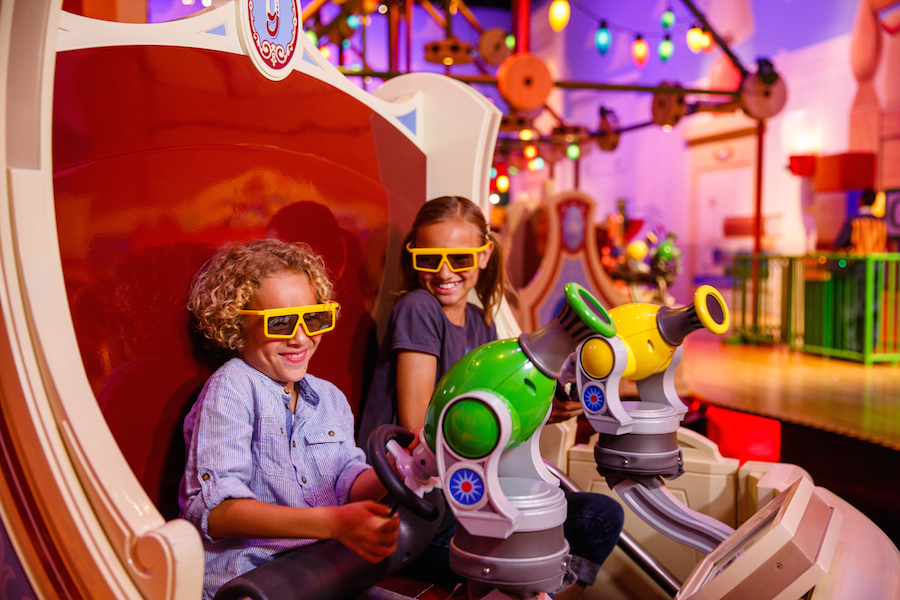
There are three Toy Story Mania rides – in Orlando, Anaheim, and Tokyo – that all work off the same principle. Double-sided, paired vehicles pull into and park in alleys of screens where riders use pull-string poppers to play 3D, screen-based classic midway games like “Break-a-Plate” and “Ring-the-Bottle” as Toy Story characters cheer them on. We’ll provide layouts for two of them.
A. Toy Story Mania! (Disney’s Hollywood Studios, 2008)

Despite daydreams of the late ’80s and early ’90s, it didn’t take long after the opening of the Disney-MGM Studios before it became clear that the Orlando park wasn’t ever going to take off as a real moviemaking hub. Though the Declassified Disaster: The Backstage Studio Tour continued to whisk riders through increasingly-smaller sections of “studio” grounds and flimsily insisted “real” productions could be around any corner, the truth was that park found itself with a whole bunch of big, cavernous, beige soundstages with nothing happening side of them.
Two of the largest – Soundstage 2 and 3 – became home to Toy Story Mania in May 2008 (just five months after the park debuted a new name). The former tram route alley connecting to the ride’s entry was designated “Pixar Place” and reclad in red brick to emulate the look of Pixar’s Emeryville, California campus. Guests entered from the east (the top in our layout, above). The ride opened with two game tracks (in our layout, Blue and Yellow), but proved immensely popular (probably because it was one of the only family-friendly rides in the park). As part of the same capacity-growing initiative that added a third theater to Soarin’, Midway Mania expanded into the vacant Soundstage 1, adding a third, standalone ride track (Red) in 2016.
In 2018, Florida’s Toy Story Mania was “retconned” into the new Toy Story Land, sealing up its east entry on Pixar Place and restructuring its queue to enter from the west side. Surprisingly, the ride’s “relocation” to Toy Story Land had another effect: it made it less popular thanks to the family-friendly appeal of a new ride – Slinky Dog Dash.
B. Toy Story Midway Mania (Disney California Adventure, 2008)
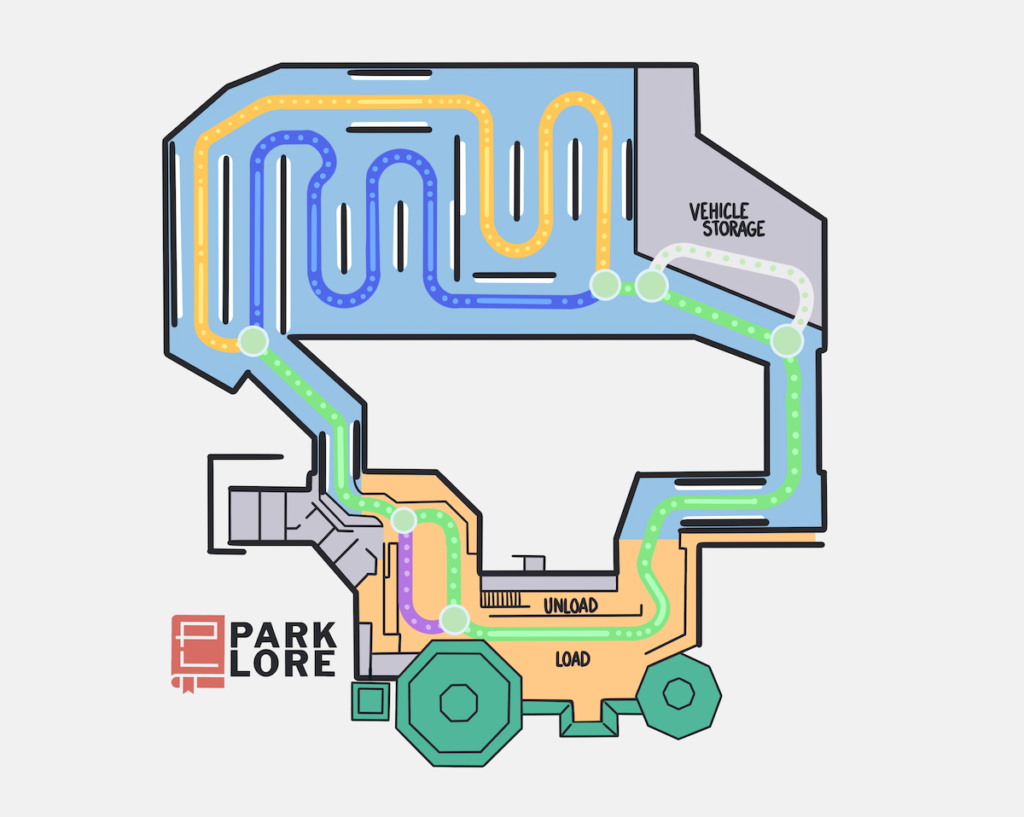
Just a month after Toy Story Mania opened at Walt Disney World, California Adventure debuted its own version of the ride (here, with its full name) as one of the first projects in the park’s $1.2 billion, five-year redesign. In addition to being a staple in designers’ work to turn back the clock on the park’s Paradise Pier (changing it from a modern seaside carnival to a turn-of-the-century boardwalk) while simultaneously introducing more Disney characters, Midway Mania had another bonus: it actually made great sense as the “games” of the pier set in a beautiful seaside Victorian dance hall.
California Adventure’s ride layout is nearly identical to the original in Florida, except for one location-specific edit. The queue and station are separated from the main ride area by the land’s enveloping roller coaster. (The “empty” space on our layout is actually where the roller coaster’s loop is.) Two enclosed corridors connect the load area to the main ride, which is wedged between the coaster’s lift hill and Katella Ave. Typical in the space-deprived parks in California where showbuildings often reside outside the parks’ “berms,” the solution is smart. Also typical for California, there’s no where to easily add a third track even though the ride’s popularity calls for one.
8. Frozen Journeys
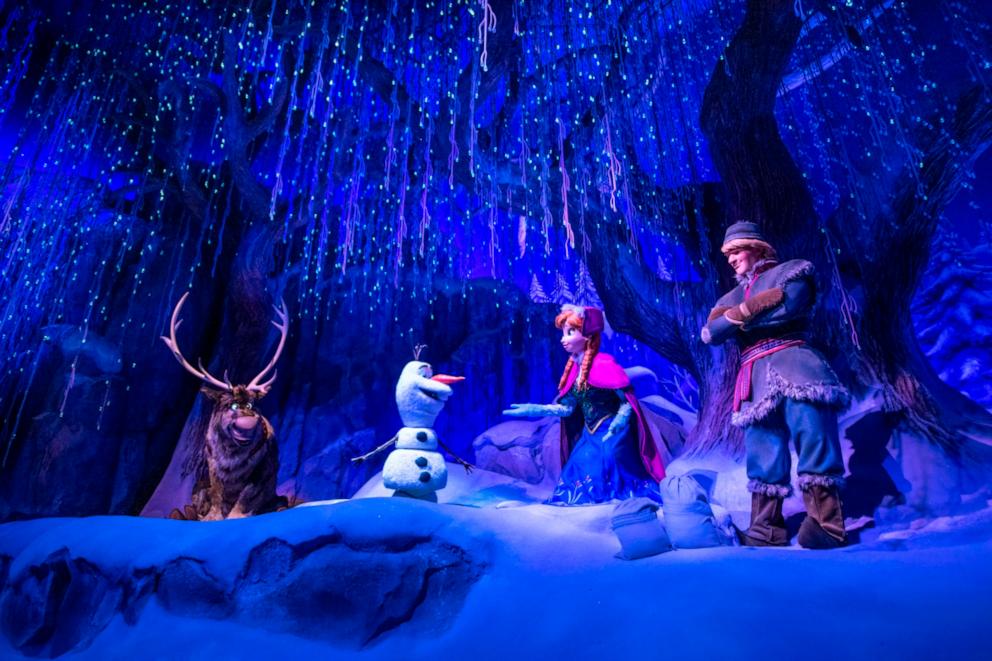
You have to remember that after the definitive end of the Disney Renaissance (1999’s Tarzan), Disney Feature Animation experience a decade-long drought of hits that only began to reverse with 2009’s The Princess and the Frog. Even so, it was 2010’s Tangled that saw Disney pivot its in-house animation studio to computer generated films, and of course, 2013’s Frozen that changed the course of the company forever.
Frozen was the kind of gargantuan hit Disney Animation hadn’t seen in a generation. With the film earning an Oscar, a Grammy, and a Golden Globe – oh, and a $1.2 billion box office haul – Frozen became the highest grossing animated film ever (surpassed by its own sequel, the $1.4 billion hit Frozen II, in 2019). Anyone who followed Disney Parks news in the early 2010s will tell you that no one was more surprised by the film’s command over pop culture than Disney, who scrambled to produce merch, meet-and-greets, and park presence to satisfy families with “Frozen Fever.”
Whereas many hits of the Renaissance waited decades to get a permanent dark ride at Disney Parks – or never did at all! – there are four Frozen-themed dark rides around the globe. Three are very nearly identical, while the fourth is something entirely different.
A. Frozen Ever After (EPCOT, 2016; Hong Kong Disneyland, 2023; Disney Adventure World, 2026)
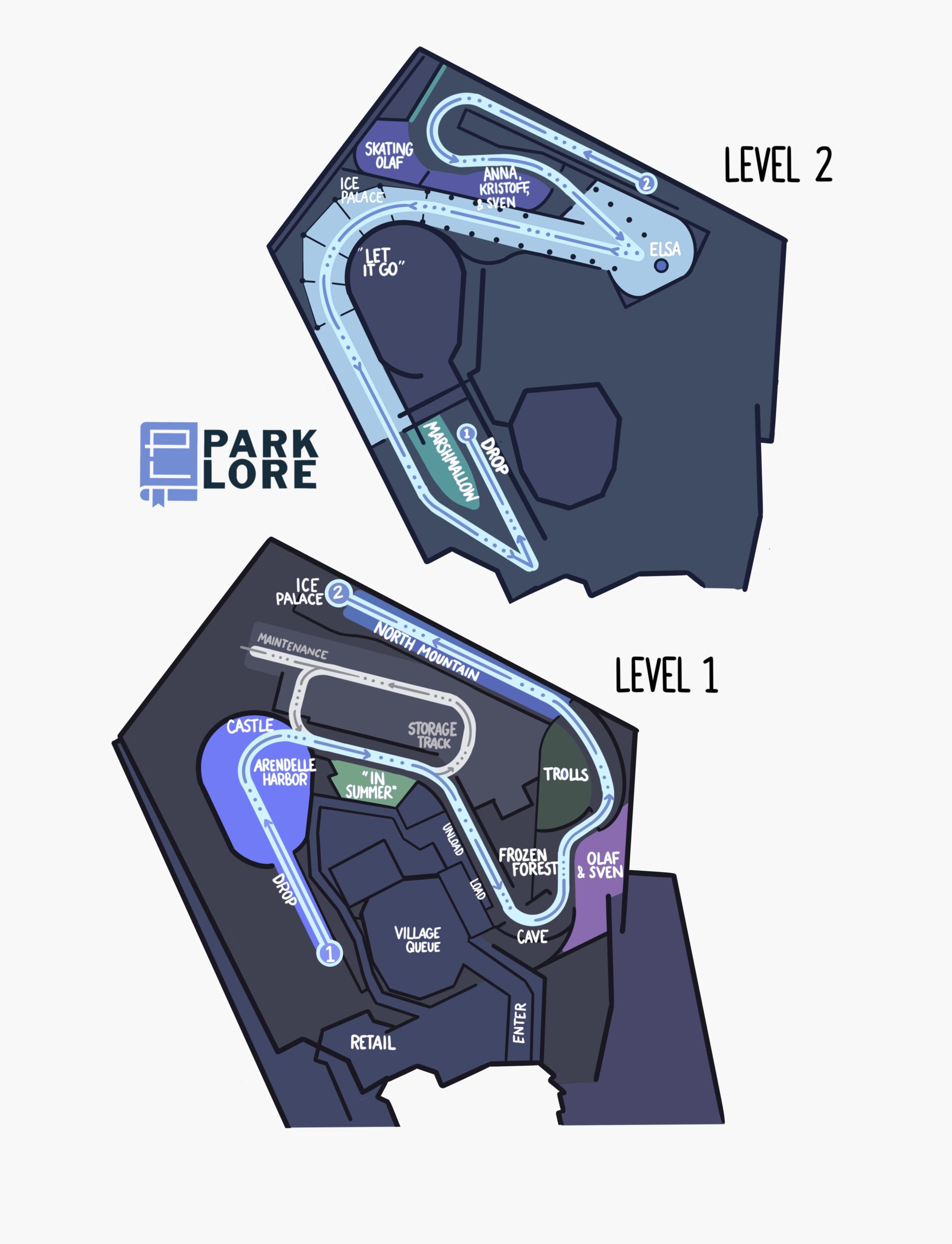
The original installation of “Frozen Ever After” debuted at EPCOT in 2016. The Florida version of the ride is unique insofar as it is actually a reskin of another ride – the Lost Legend: Maelstrom, which had anchored EPCOT’s Norway pavilion since 1988. As you might’ve seen in our THEN & NOW layout comparison between the two, not much of Maelstrom remains in Frozen Ever After – except, of course, its short and odd layout, wrapped around a former theater in the pavilion’s core.
Designers clearly did a nice job re-using what the inherited from Maelstrom, and found a way to repurpose the former ride’s built-in elements (including an ascent, a turntable leading to a backwards track section, and a drop) into a ride that hits the major songs and plot points of Frozen – and without just being a book report retelling. But there’s really no question that Frozen deserved a better ride than even the most spectacular re-wrap of a 1988 flume would’ve made possible.
That makes it especially odd that when Hong Kong Disneyland and Disney Adventure World (previously Walt Disney Studios) in Paris decided to make Frozen-themed lands the headlining projects of multi-year expansions, they both opted to basically duplicate EPCOT’s reverse-engineered Frozen ride. Though the Chinese and French versions are in custom showbuildings with roomier scenes and slight edits to the ride’s track layout, both versions of “Frozen Ever After” still follow the same scenes in the same order you’ll find in EPCOT… and they’re still quite short! (Their “plus” is that they have full animatronic faces rather than the projected faces you’ll find in Walt Disney World’s version.)
B. Anna & Elsa’s Frozen Journey (Tokyo DisneySea, 2024)
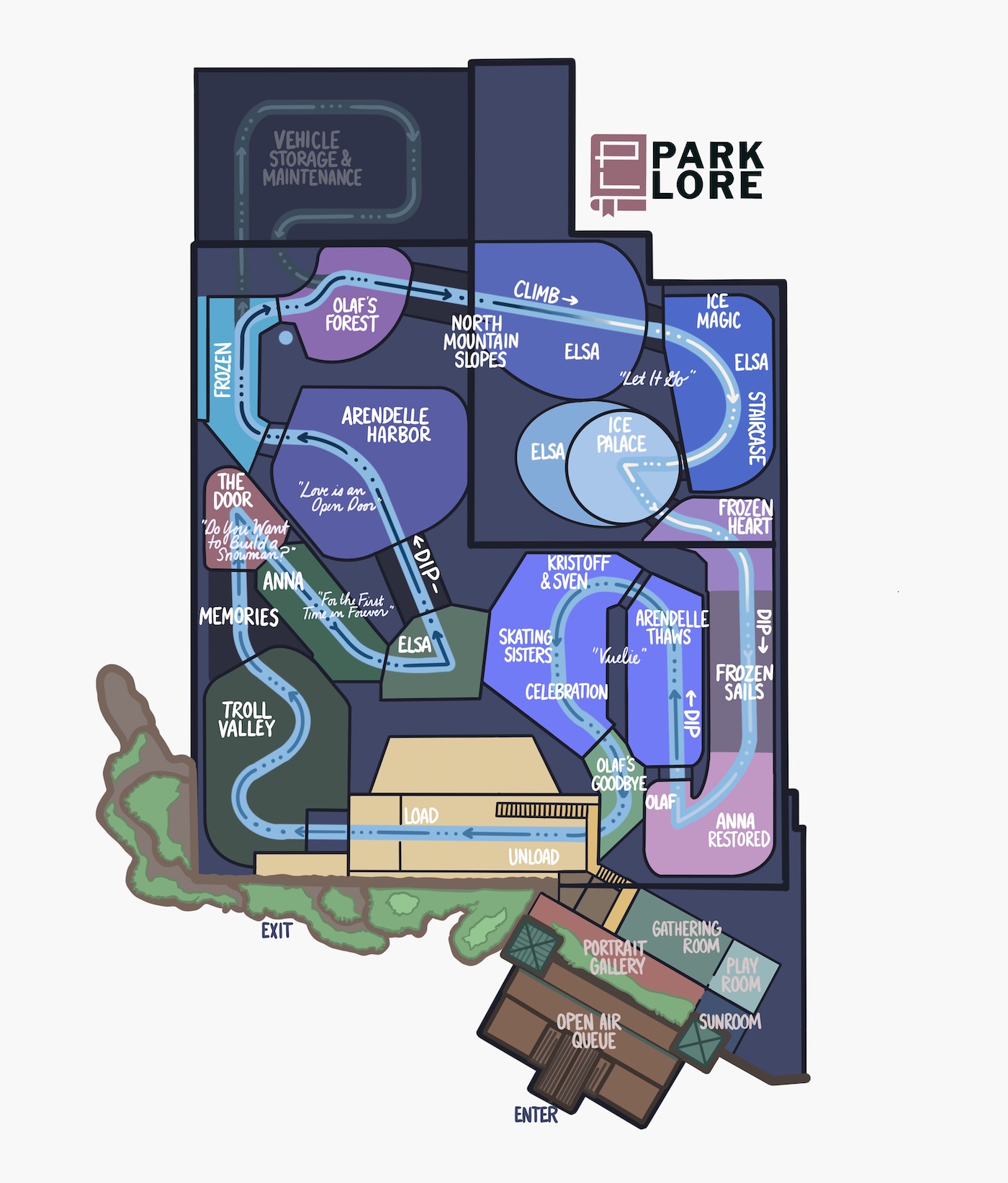
It’s worth noting again and again that Tokyo Disney Resort is neither owned nor operated by the Walt Disney Company. Instead of theme parks being revenue-generating profit centers for an international media conglomerate whose cash must be maximized at all costs, the Japanese parks are the main endeavor of the Oriental Land Company (OLC) that owns and operates them. Just as OLC pays Disney to use its characters and brands, it also contracts with Walt Disney Imagineering separate from their work with the U.S. parks. So if you feel that Tokyo always gets the “Blue Sky” version of something, you’re usually right!
Such is certainly the case with Tokyo’s Frozen ride – “Anna & Elsa’s Frozen Journey.” One of three staggering E-Ticket dark rides in a 2024 expansion of Tokyo DisneySea called Fantasy Springs, the Japanese Frozen ride must be seen to be believed. Sure, it’s a “book report” ride, retelling the 90 minute tale you know in a brisk six minute cruise… but Anna & Elsa’s Frozen Journey also contains some of the most spectacular moments in any Disney dark ride. Several moments from the ride have gone viral online thanks to the jaw-dropping animatronics involved, if that tells you anything!
The staging of some scenes is clearly gleaned from the “Frozen Ever After” ride, but Anna & Elsa’s Frozen Journey is set-up more like a stage show that you happen to float through. The characters don’t interact or address you as they do in the “Ever After” concept. The ride also isn’t afraid to touch on the downright heartbreaking moments from the film – like a young Elsa closing out her little sister, Elsa’s initial frustration-fueled release of powers, or Anna being struck in the heart by her sister’s magic. It’s a totally different interpretation of what a Frozen ride can be – but we’ll leave you to decide if you prefer the style “here or there…”


